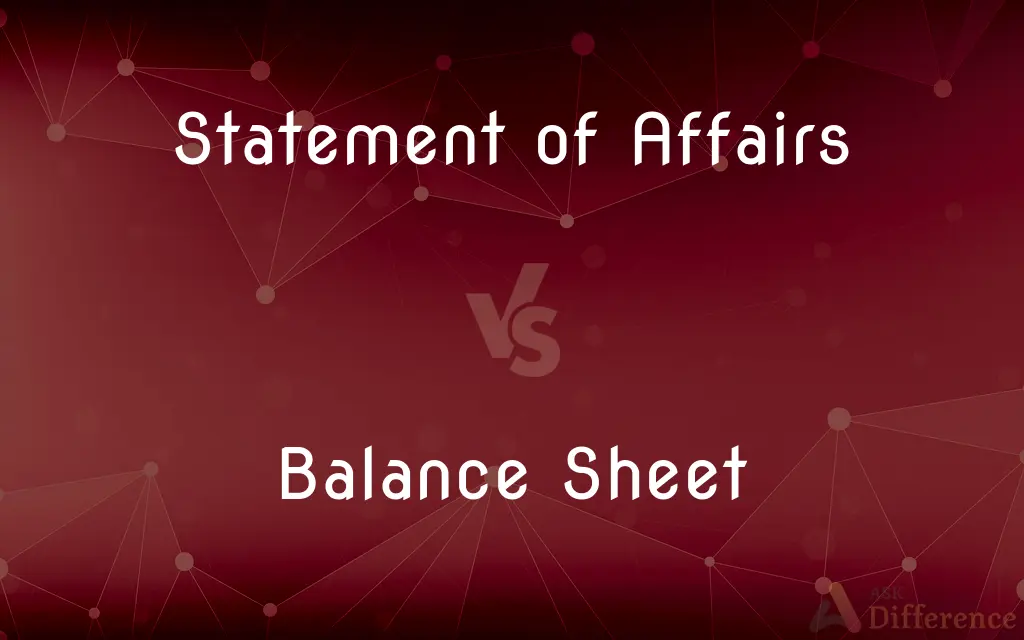Statement of Affairs vs. Balance Sheet — What's the Difference?
Edited by Tayyaba Rehman — By Fiza Rafique — Published on December 28, 2023
The Statement of Affairs provides an overview of an entity's assets and liabilities, often for insolvency or bankruptcy situations, while a Balance Sheet is a formal financial statement that summarizes an entity's assets, liabilities.

Difference Between Statement of Affairs and Balance Sheet
Table of Contents
ADVERTISEMENT
Key Differences
The Statement of Affairs is a document that provides an overview of an entity's assets and liabilities, typically prepared in situations like insolvency or bankruptcy. It offers a snapshot of what an entity owns and owes, aimed at giving creditors an understanding of the financial position. On the other hand, a Balance Sheet is a standard financial statement used by businesses and other organizations to showcase their financial health at a specific date.
While both the Statement of Affairs and the Balance Sheet provide insights into assets and liabilities, their purposes and contexts differ. The Statement of Affairs is often less formal and is more about providing a transparent view to creditors in adverse situations. The Balance Sheet, however, is a structured presentation, essential for financial reporting, and is used by stakeholders like investors, analysts, and regulators to assess financial health and performance.
Another distinction between the Statement of Affairs and the Balance Sheet lies in their periodicity. While the Balance Sheet is typically prepared at regular intervals, like quarterly or annually, the Statement of Affairs is prepared on an ad hoc basis, specifically for events like bankruptcy.
Furthermore, the Balance Sheet emphasizes on showing the equity or net worth (assets minus liabilities) of an entity, providing a holistic view of the financial position. The Statement of Affairs, while it might show a deficit in cases of insolvency, mainly focuses on the realization of assets and the likely outcome for creditors.
In essence, while both documents shed light on assets and liabilities, the Statement of Affairs is primarily for crisis situations, giving creditors clarity, whereas the Balance Sheet is a regular financial report reflecting the overall health and performance of an entity.
ADVERTISEMENT
Comparison Chart
Purpose
Provides overview in insolvency/bankruptcy
Shows financial position at a specific date
Formality
Often less formal
Structured financial statement
Periodicity
Ad hoc, typically for specific events
Regular intervals, e.g., quarterly or annually
Primary Users
Creditors in insolvency situations
Investors, analysts, regulators
Focus
Realization of assets, outcome for creditors
Assets, liabilities, and equity/net worth
Compare with Definitions
Statement of Affairs
It provides clarity to creditors in adverse financial situations.
The Statement of Affairs was crucial in helping creditors understand the company's dire state.
Balance Sheet
It provides a snapshot of an entity's financial health at a specific date.
Investors frequently analyze the Balance Sheet to assess a company's solvency.
Statement of Affairs
The Statement of Affairs is event-driven, produced for specific situations.
When insolvency loomed, the firm's management quickly compiled a Statement of Affairs.
Balance Sheet
The Balance Sheet emphasizes the net worth or equity of an entity.
The CEO was pleased to see the increased equity section on the Balance Sheet.
Statement of Affairs
The Statement of Affairs is an overview of assets and liabilities, typically during insolvency.
When the company filed for bankruptcy, they presented their Statement of Affairs to creditors.
Balance Sheet
This statement is essential for regular financial reporting.
At each quarter's close, the finance team finalized the Balance Sheet.
Statement of Affairs
This statement often prioritizes the realization value of assets.
The Statement of Affairs showed a lower asset value, focusing on the potential liquidation price.
Balance Sheet
The Balance Sheet helps stakeholders gauge financial performance and stability.
Analysts often compare consecutive Balance Sheets to trace financial trends.
Statement of Affairs
The Statement of Affairs is prepared for creditors to gauge the financial situation in crisis times.
Creditors reviewed the Statement of Affairs to determine how much they could recover.
Balance Sheet
The Balance Sheet is a financial statement showing assets, liabilities, and equity.
The Balance Sheet revealed the company's robust financial position at year-end.
Common Curiosities
How does a Balance Sheet differ from an income statement?
While a Balance Sheet shows assets, liabilities, and equity at a specific date, an income statement reflects revenues and expenses over a period.
Do both the Statement of Affairs and Balance Sheet show assets and liabilities?
Yes, both provide insights into assets and liabilities, but their purposes and contexts differ.
How does the Statement of Affairs benefit creditors?
It offers transparency in adverse situations, helping creditors gauge potential recoveries.
What is the main purpose of a Statement of Affairs?
The Statement of Affairs provides an overview of assets and liabilities, often in insolvency or bankruptcy situations.
How often is a Balance Sheet prepared by businesses?
Businesses typically prepare a Balance Sheet at regular intervals, like quarterly or annually.
Who primarily uses the Balance Sheet for decision-making?
Investors, analysts, regulators, and other stakeholders use the Balance Sheet to assess financial health.
Is the Balance Sheet a mandatory report for public companies?
Yes, public companies are required to publish their Balance Sheet as part of their regular financial statements.
In what scenarios is a Statement of Affairs typically prepared?
It's generally prepared in situations like insolvency, bankruptcy, or other financial crises.
Does the Statement of Affairs always indicate insolvency?
While often associated with insolvency, it provides a financial overview, which might also highlight solvency in specific cases.
How is equity presented on the Balance Sheet?
Equity, the difference between assets and liabilities, is shown as a separate section on the Balance Sheet.
What does the realization value in a Statement of Affairs indicate?
It indicates the estimated value of assets if they were to be liquidated or sold off.
Share Your Discovery

Previous Comparison
Indian Education vs. Western Education
Next Comparison
Christian Standard Bible vs. NIVAuthor Spotlight
Written by
Fiza RafiqueFiza Rafique is a skilled content writer at AskDifference.com, where she meticulously refines and enhances written pieces. Drawing from her vast editorial expertise, Fiza ensures clarity, accuracy, and precision in every article. Passionate about language, she continually seeks to elevate the quality of content for readers worldwide.
Edited by
Tayyaba RehmanTayyaba Rehman is a distinguished writer, currently serving as a primary contributor to askdifference.com. As a researcher in semantics and etymology, Tayyaba's passion for the complexity of languages and their distinctions has found a perfect home on the platform. Tayyaba delves into the intricacies of language, distinguishing between commonly confused words and phrases, thereby providing clarity for readers worldwide.













































